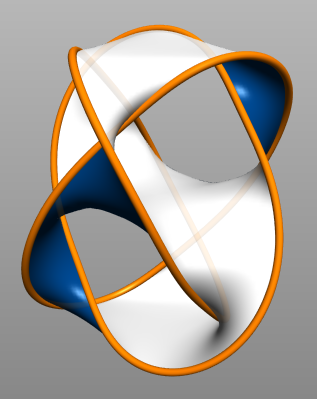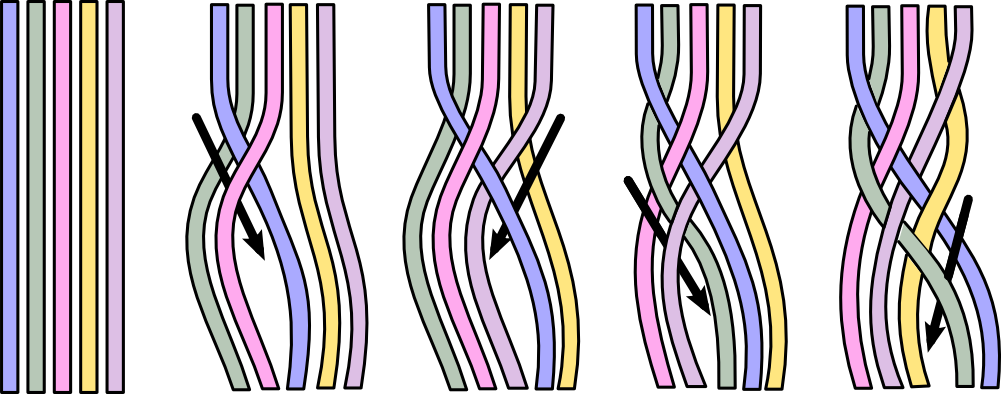|
Torus Knot
In knot theory, a torus knot is a special kind of knot (mathematics), knot that lies on the surface of an unknotted torus in R3. Similarly, a torus link is a link (knot theory), link which lies on the surface of a torus in the same way. Each torus knot is specified by a pair of coprime integers ''p'' and ''q''. A torus link arises if ''p'' and ''q'' are not coprime (in which case the number of components is greatest common divisor, gcd(''p, q'')). A torus knot is unknot, trivial (equivalent to the unknot) if and only if either ''p'' or ''q'' is equal to 1 or −1. The simplest nontrivial example is the (2,3)-torus knot, also known as the trefoil knot. Geometrical representation A torus knot can be rendered geometrically in multiple ways which are topologically equivalent (see Properties below) but geometrically distinct. The convention used in this article and its figures is the following. The (''p'',''q'')-torus knot winds ''q'' times around a circle in the interior of t ... [...More Info...] [...Related Items...] OR: [Wikipedia] [Google] [Baidu] |
Cylindrical Coordinates
A cylinder () has traditionally been a three-dimensional solid, one of the most basic of curvilinear geometric shapes. In elementary geometry, it is considered a prism with a circle as its base. A cylinder may also be defined as an infinite curvilinear surface in various modern branches of geometry and topology. The shift in the basic meaning—solid versus surface (as in a solid ball versus sphere surface)—has created some ambiguity with terminology. The two concepts may be distinguished by referring to solid cylinders and cylindrical surfaces. In the literature the unadorned term "cylinder" could refer to either of these or to an even more specialized object, the '' right circular cylinder''. Types The definitions and results in this section are taken from the 1913 text ''Plane and Solid Geometry'' by George A. Wentworth and David Eugene Smith . A ' is a surface consisting of all the points on all the lines which are parallel to a given line and which pass through a ... [...More Info...] [...Related Items...] OR: [Wikipedia] [Google] [Baidu] |
Dunce Hat (topology)
In topology, the dunce hat is a compact space, compact topological space formed by taking a solid triangle and Quotient space (topology), gluing all three sides together, with the orientation of one side reversed. Simply gluing two sides oriented in the opposite direction would yield a cone much like the Dunce#Dunce cap, dunce cap, but the gluing of the third side results in identifying the base of the cap with a line joining the base to the point. Name The name is due to Christopher Zeeman, E. C. Zeeman, who observed that any contractible space, contractible 2-complex (such as the dunce hat) after taking the Cartesian product with the unit interval, closed unit interval seemed to be collapsible. This observation became known as the Zeeman conjecture and was shown by Zeeman to imply the Poincaré conjecture. Properties The dunce hat is contractible space, contractible, but not piecewise-linear collapse, collapsible. Contractibility can be easily seen by noting that the dunce hat e ... [...More Info...] [...Related Items...] OR: [Wikipedia] [Google] [Baidu] |
Seifert Fiber Space
A Seifert fiber space is a 3-manifold together with a decomposition as a disjoint union of circles. In other words, it is a S^1-bundle ( circle bundle) over a 2-dimensional orbifold. Many 3-manifolds are Seifert fiber spaces, and they account for all compact oriented manifolds in 6 of the 8 Thurston geometries of the geometrization conjecture. Definition A Seifert manifold is a closed 3-manifold together with a decomposition into a disjoint union of circles (called fibers) such that each fiber has a tubular neighborhood that forms a standard fibered torus. A standard fibered torus corresponding to a pair of coprime integers (a,b) with a>0 is the surface bundle of the automorphism of a disk given by rotation by an angle of 2\pi b/a (with the natural fibering by circles). If a=1 the middle fiber is called ordinary, while if a>1 the middle fiber is called exceptional. A compact Seifert fiber space has only a finite number of exceptional fibers. The set of fibers forms a 2-dimensi ... [...More Info...] [...Related Items...] OR: [Wikipedia] [Google] [Baidu] |
3-sphere
In mathematics, a hypersphere or 3-sphere is a 4-dimensional analogue of a sphere, and is the 3-dimensional n-sphere, ''n''-sphere. In 4-dimensional Euclidean space, it is the set of points equidistant from a fixed central point. The interior of a 3-sphere is a 4-ball. It is called a 3-sphere because topologically, the surface itself is 3-dimensional, even though it is curved into the 4th dimension. For example, when traveling on a 3-sphere, you can go north and south, east and west, or along a 3rd set of cardinal directions. This means that a 3-sphere is an example of a 3-manifold. Definition In coordinates, a 3-sphere with center and radius is the set of all points in real, Four-dimensional space, 4-dimensional space () such that :\sum_^3(x_i - C_i)^2 = ( x_0 - C_0 )^2 + ( x_1 - C_1 )^2 + ( x_2 - C_2 )^2+ ( x_3 - C_3 )^2 = r^2. The 3-sphere centered at the origin with radius 1 is called the unit 3-sphere and is usually denoted : :S^3 = \left\. It is often convenient to r ... [...More Info...] [...Related Items...] OR: [Wikipedia] [Google] [Baidu] |
Jones Polynomial
In the mathematical field of knot theory, the Jones polynomial is a knot polynomial discovered by Vaughan Jones in 1984. Specifically, it is an invariant of an oriented knot or link which assigns to each oriented knot or link a Laurent polynomial in the variable t^ with integer coefficients. Definition by the bracket Suppose we have an oriented link L, given as a knot diagram. We will define the Jones polynomial V(L) by using Louis Kauffman's bracket polynomial, which we denote by \langle~\rangle. Here the bracket polynomial is a Laurent polynomial in the variable A with integer coefficients. First, we define the auxiliary polynomial (also known as the normalized bracket polynomial) :X(L) = (-A^3)^\langle L \rangle, where w(L) denotes the writhe of L in its given diagram. The writhe of a diagram is the number of positive crossings (L_ in the figure below) minus the number of negative crossings (L_). The writhe is not a knot invariant. X(L) is a knot invariant si ... [...More Info...] [...Related Items...] OR: [Wikipedia] [Google] [Baidu] |
Alexander Polynomial
In mathematics, the Alexander polynomial is a knot invariant which assigns a polynomial with integer coefficients to each knot type. James Waddell Alexander II discovered this, the first knot polynomial, in 1923. In 1969, John Conway showed a version of this polynomial, now called the Alexander–Conway polynomial, could be computed using a skein relation, although its significance was not realized until the discovery of the Jones polynomial in 1984. Soon after Conway's reworking of the Alexander polynomial, it was realized that a similar skein relation was exhibited in Alexander's paper on his polynomial. Definition Let ''K'' be a knot in the 3-sphere. Let ''X'' be the infinite cyclic cover of the knot complement of ''K''. This covering can be obtained by cutting the knot complement along a Seifert surface of ''K'' and gluing together infinitely many copies of the resulting manifold with boundary in a cyclic manner. There is a covering transformation ''t'' acting on ''X ... [...More Info...] [...Related Items...] OR: [Wikipedia] [Google] [Baidu] |
Knot Genus
In mathematics, a Seifert surface (named after German mathematician Herbert Seifert) is an orientable surface whose boundary is a given knot or link. Such surfaces can be used to study the properties of the associated knot or link. For example, many knot invariants are most easily calculated using a Seifert surface. Seifert surfaces are also interesting in their own right, and the subject of considerable research. Specifically, let ''L'' be a tame oriented knot or link in Euclidean 3-space (or in the 3-sphere). A Seifert surface is a compact, connected, oriented surface ''S'' embedded in 3-space whose boundary is ''L'' such that the orientation on ''L'' is just the induced orientation from ''S''. Note that any compact, connected, oriented surface with nonempty boundary in Euclidean 3-space is the Seifert surface associated to its boundary link. A single knot or link can have many different inequivalent Seifert surfaces. A Seifert surface must be oriented. It is possible to ass ... [...More Info...] [...Related Items...] OR: [Wikipedia] [Google] [Baidu] |
Crossing Number (knot Theory)
In the mathematics, mathematical area of knot theory, the crossing number of a knot (mathematics), knot is the smallest number of crossings of any diagram of the knot. It is a knot invariant. Examples By way of example, the unknot has crossing number 0 (number), zero, the trefoil knot three and the figure-eight knot (mathematics), figure-eight knot four. There are no other knots with a crossing number this low, and just two knots have crossing number five, but the number of knots with a particular crossing number increases rapidly as the crossing number increases. Tabulation Tables of prime knots are traditionally indexed by crossing number, with a subscript to indicate which particular knot out of those with this many crossings is meant (this sub-ordering is not based on anything in particular, except that torus knots then twist knots are listed first). The listing goes 31 (the trefoil knot), 41 (the figure-eight knot), 51, 52, 61, etc. This order has not changed significa ... [...More Info...] [...Related Items...] OR: [Wikipedia] [Google] [Baidu] |
Braid Word
In mathematics, the braid group on strands (denoted B_n), also known as the Artin braid group, is the group whose elements are equivalence classes of -braids (e.g. under ambient isotopy), and whose group operation is composition of braids (see ). Example applications of braid groups include knot theory, where any knot may be represented as the closure of certain braids (a result known as Alexander's theorem); in mathematical physics where Artin's canonical presentation of the braid group corresponds to the Yang–Baxter equation (see ); and in monodromy invariants of algebraic geometry. Introduction In this introduction let ; the generalization to other values of will be straightforward. Consider two sets of four items lying on a table, with the items in each set being arranged in a vertical line, and such that one set sits next to the other. (In the illustrations below, these are the black dots.) Using four strands, each item of the first set is connected with an item of the s ... [...More Info...] [...Related Items...] OR: [Wikipedia] [Google] [Baidu] |
Braid Theory
In mathematics, the braid group on strands (denoted B_n), also known as the Artin braid group, is the group whose elements are equivalence classes of -braids (e.g. under ambient isotopy), and whose group operation is composition of braids (see ). Example applications of braid groups include knot theory, where any knot may be represented as the closure of certain braids (a result known as Alexander's theorem); in mathematical physics where Artin's canonical presentation of the braid group corresponds to the Yang–Baxter equation (see ); and in monodromy invariants of algebraic geometry. Introduction In this introduction let ; the generalization to other values of will be straightforward. Consider two sets of four items lying on a table, with the items in each set being arranged in a vertical line, and such that one set sits next to the other. (In the illustrations below, these are the black dots.) Using four strands, each item of the first set is connected with an item of t ... [...More Info...] [...Related Items...] OR: [Wikipedia] [Google] [Baidu] |




